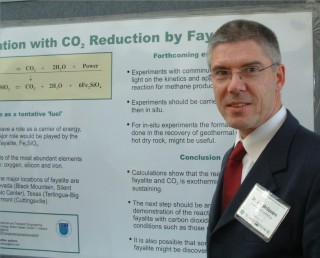Third Annual Conference on Carbon Capture and Sequestration
Others involved: Nikolay Akinfiev and Evgeny Yantovski (co-authors)
Jim McGovern attended and presented a paper by poster session at the Third Annual Conference on Carbon Capture & Sequestration, which took place in Alexandria, Virginia, from May 3rd to 6th, 2004. The conference was organised by the United States Department of Energy and NETL, the National Energy Technology Laboratory. The theme of the conference was 'Building on the Current Technology Base to Provide Viable Options to Reduce Carbon Intensity'. The conference focused on carbon capture, separation and sequestration technologies that could be deployed in the U.S. and North America.
More than 450 participants from 21 countries attended; 80 people had come from countries outside the U.S. The welcome remarks and the closing remarks were by Ms. Rita Bajura, Director, U.S. Department of Energy, National Energy Technology laboratory. The conference was addressed by the Honorable Spencer Abraham, Secretary, U.S. Department of Energy, which was a good indication that carbon management had become a top priority under President George Bush.
A very broad range of topics was covered during the conference and it was clear that many researchers in the US and around the world are actively engaged in addressing carbon capture and sequestration issues. For example, deep coal seams and deep saline reservoirs could hold vast quantities of CO2.
In several of the presentations it was indicated that the U.S. government was promoting clean coal power initiatives, most notably FutureGen, a $1 billion, 10-year, zero-emissions demonstration project, and urging that generation efficiencies should be pushed towards 60%. It also supported effective, safe, permanent carbon sequestration and commercial hydrogen production.
Many papers discussed storage in geological formations and it was clear that much relevant expertise already existed. The consequences, implications and practicalities of such storage were being examined in great detail: e.g. monitoring, safety assurance, storage verification, early warnings of project failure, risk assessment, potential for leakage, site characterisation, possible modes of failure, remediation options, and groundwater implications. Various technologies for capturing CO2 from stationary sources were described. The main pre-combustion process type involved the production of synthesis gas from coal followed by a water gas shift reaction to yield hydrogen and CO2. The main post-combustion process type involved the use of solvents for CO2 removal. So called oxy processes, wherein the fuel would be burned in oxygen without nitrogen, were also described and there was mention too of combustion in a mixture of recirculated CO2 and oxygen. Regional Carbon Sequestration Projects were described: these involved preparatory work for carbon sequestration through assessing sources and potential sequestration sinks for major regions of the U.S. Increased CO2 retention in soil and in plants (e.g. through reforestation) was also an area of significant activity, which also involved ways of accounting for 'natural' carbon sequestration. There were papers dealing with carbon trading, including one on the Chicago Climate Exchange. In her summing up, Ms. Rita Bajura mentioned that in the third conference a plethora of results had been presented and there had been a deeper identification and characterisation of problems. A further conference in the series was already planned for 2005.

Jim McGovern in front of his poster presentation
at the conference on 4th May 2004.
Some relevant web sites are:
- http://www.carbonsq.com/
- http://www.fossil.energy.gov/programs/powersystems/futuregen/
- http://www.globalchange.gov/
- http://www.climatevision.gov/
- http://www.netl.doe.gov/
- http://www.chicagoclimatex.com/
Updated 20 May 2012